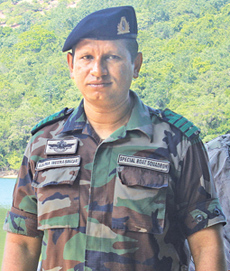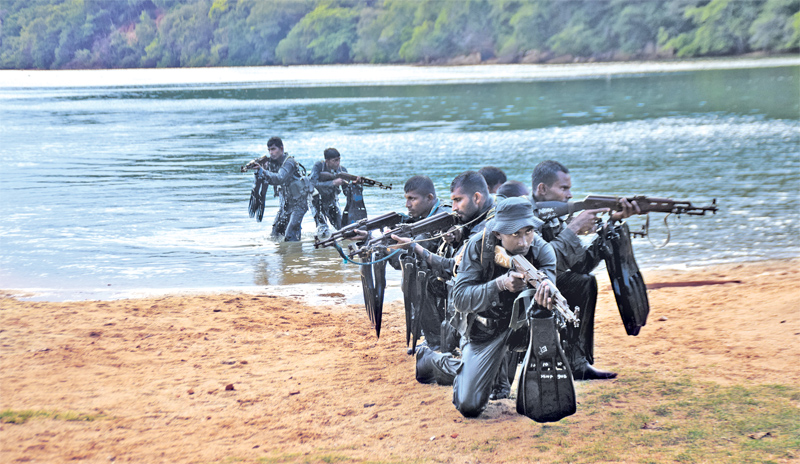
One of the elite units of the Navy is the Special Boat Squadron (SBS). They are the toughest and well trained water borne fighters in our country. They perform their tasks with stealth and speed surprising the enemy.
 Captain Aruna Weerasinghe |
During a visit to Trimcomalee I was able to visit their headquarters located deep within dense forest, at an undisclosed location. The drive took me along paths where deer and monkey crossed at random. Upon reaching their camp the first image visible was that of a mounted black statue beneath which the squadrons motto was painted ‘Fortune favours the Brave’.
The Commanding officer of the SBS is Captain Aruna Weerasinghe, a veteran who has 20 years of combat experience. The history of this outfit dates back to 1993 when a dynamic young man Lt.Cdr. Ravi Wijegunartne was inspired to form a special unit with rapid strike capability (he rose to become an Admiral, as Commander of the Navy and serves today as the Chief of Defence Staff). Along with a comrade Cdr. Cedric Martinstien there were 30 men who volunteered for this dangerous task at that time. Later a total of 78 sailors also became part of the team. Training in the secluded beaches of Karainagar the team enhanced their skills. Cdr. Cedric was later killed in action. To date the navy proudly uses the ‘Cedric’ boats designed and built by this innovative officer.
Joining the SBS is not an easy task. It is a process that tests your physical and mental endurance. Prospective candidates are enlisted persons from the navy. They have to pass a hard PT test that includes swimming. Once chosen they are committed to 1 long year of training. Stage 1 has 6 weeks of orientation where the trainee is made physically fit. During this year they do endurance marches beginning from 3Km and going up to 30 Km carrying a full pack with assault rifle. The teams firing capability is increased along with swimming skills. Combat swimming is very different from swimming in a pool. Here the fighter must not make any noise or cause ripples in the water.
The teams operate in the sea, lagoon and river: each area of water presenting its natural hazards. Recruits are taught to stay submerged in the water for many hours at times encountering jelly fish that deliver a painful sting. During the jungle training phase these young men must navigate the forest paths by day and night. The jungle has its own wild threats from lone elephants, roaming bears and poisonous snakes. Each man must do a 4 km jungle trek at night alone.
8 man team
Once they have completed the training the men will operate in small teams. According to Capt. Weerasinghe the 8 man team has a leader, scout, gunners, communicator and medic. They have undertaken dangerous missions often going behind enemy lines. During these days they survive on high protein ration packs, as cooking will give away your concealed position. Those who excel in these tasks are absorbed into the highly covert LRRP Team (Long Range Reconnaissance Patrol). The SBS has members who specialize as snipers, combat divers and parachute jumpers.
Over the years the squadron has expanded its mission capability, being able to excel in jungle and maritime warfare, asymmetric warfare, urban fighting and VBSS. The VBSS teams (vessel boarding and sea search) really enjoy high octane action. They excel in anti- ship hijack operations. The SBS has now reached new heights of excellence where they train naval commandos from USA, China, India, Pakistan and Nigeria. Joining the navy and becoming a member of the SBS is the ultimate career and action filled with adventure for any young man.

